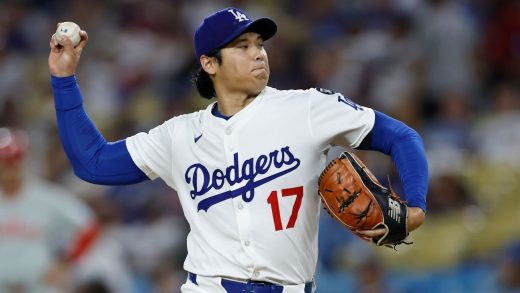Early in the season, it’s typical to hear a lot about the pace of certain stats. “Rams wide receiver Puka Nacua is on pace for 178 catches and 2,100 yards,” that sort of the thing. But most of the time when you see “on pace for” stats, you have no idea of which teams and players were on pace for similar things in the past.
Over time, performances usually regress toward the mean: Teams and players that started hot slow down, and those that initially struggled tend to improve. We don’t want to compare a performance after four games to what others have done in full 16- and 17-game seasons. We should compare it to what was done in the same span.
I do that with DVOA (defense-adjusted value over average), explained further here. I’ve gone back and reran every season since 1978 to see what DVOA would have looked like as of a certain week in the past. Teams are rated solely through four games, and opponent adjustments are based only on opponents through four games.
I’ve written similar pieces in the past, but there aren’t many teams playing at a historic level this season. In particular, the best teams are not historically great.
The Seahawks are a surprising No. 1 in DVOA right now, led by the league’s top defense. But they are the No. 32 team since 1978 through four weeks, and they aren’t even one of the 100 top defenses. The Bills — the No. 1 offense this season — rank 71st among offenses since 1978.
What we do have this season are two particularly bad defenses, a weak start for the defending champions and Nacua threatening the receptions record. Let’s see where those performances through four games compare to history, and then look at what happened in the past to learn what might happen the rest of the season.

![]()
The Dallas Cowboys have the eighth-worst pass defense
Our first trend won’t surprise you if you’ve watched the Cowboys this season: They are horrendous at stopping opposing quarterbacks.
We didn’t see it in Week 1, as the Eagles’ Jalen Hurts had only 152 passing yards, but there was a hint when he completed 19 of 23 passes. The Giants’ Russell Wilson had 450 yards in a Week 2 overtime game, Bears QB Caleb Williams came alive with 298 yards and four touchdowns in Week 3; then the Packers’ Jordan Love had 337 yards in a Week 4 overtime tie.
The Cowboys have allowed the most passing yards (1,189 yards), passing touchdowns (10, tied with Chicago) and net yards per pass attempt (8.5, with no other team above 8.0) this season. As a result, Dallas ranks eighth among the worst pass defenses. (These numbers are positive because they represent positive success for the opposing offenses.)
It was expected that the Cowboys’ pass defense would be a problem after they traded edge rusher Micah Parsons before the season, but not this bad. Especially since Dallas has players in the secondary who have been very good in the past. Cornerback Trevon Diggs was a first-team All-Pro in 2021, and fellow CB DaRon Bland was a first-team All-Pro in 2023.
However, the pass rush is struggling as expected. The Cowboys currently rank 27th in pass rush win rate (30.4%). As for the back seven, new defensive coordinator Matt Eberflus has the Cowboys playing more zone coverage than anyone else (84% of snaps, according to ESPN Research), but it’s not working.
What we can expect: There should be some regression to the mean here. No team has ever finished a full season with a pass defense as bad as what Dallas has shown so far.
The highest net yards per pass average allowed since 1978 was 8.2 by the 1981 Baltimore Colts. Since then, no team has allowed more than 8.0 net yards per pass through a full season. The 1981 Colts also had the worst pass defense DVOA ever, at 50.0%.
Most defenses on our top-10 list finished the season among the league’s worst pass defenses, although the 1984 Eagles improved to be roughly league average for the whole season. All of these teams also finished with losing records, except for the 1979 Jets. To find a team with a terrible pass defense in the first four games that finished the season with a winning record, you have to go all the way down to No. 34, the 2016 Detroit Lions. They finished 9-7 and lost to the Seahawks in the wild-card round.
If there’s any hope, it’s for future seasons. After all, the Cowboys have two picks in the first round of the 2026 draft that they can use to help rebuild their defense. The 2023 Broncos improved enough to have the No. 4 defense overall in 2024. But most of these pass defenses stayed bad all season and were bad the following year as well.
![]()
The New York Giants have the third-worst run defense
This one might be a bit more of a surprise unless you had Omarion Hampton on your fantasy team last week.
The official NFL stats based on total yardage don’t have the Giants as the worst run defense — they currently rank fourth-worst with 612 yards allowed on the ground. But New York is tied with the Bears for last in yards per attempt (6.1). If we leave out quarterback scrambles and end-of-half kneel-downs, the Giants are allowing 6.2 yards per carry this season. Chicago is at 5.9, and no other team is above 5.5.
New York has allowed only one 100-yard rusher all season, Hampton in Week 4, but they’re allowing good efficiency to almost everyone who carries the rock against them.
It’s interesting to consider that the Giants currently rank 12th in run stop win rate (31.1%). But watch out when running backs get to the second level. Currently, the Giants are allowing 1.83 open-field yards — more than 10 yards past the line of scrimmage. Only Chicago’s defense is worse.
What we can expect: The highest average yards per carry allowed since 1978 was 5.4 by the 2022 Chargers. The 1983 Houston Oilers have the worst run defense DVOA for a full season at 20.6%. So both of those numbers should improve for the Giants.
The run stop win rate suggests that the Giants’ run defense is playing better than the results would otherwise indicate. It’s likely that things will improve and New York does a better job of stopping opposing running backs.
And, as you can see from the table, teams with terrible early run defenses don’t necessarily finish the season as bad teams. Our top 10 has two teams with winning records, partly because the run defense is not as important as pass defense. The bigger problem is whether the Giants can be successful with a rookie quarterback in Jaxson Dart and no No. 1 wide receiver in Malik Nabers (torn ACL).
![]()
We went through this last season with the Chiefs, as many stats showed the Chiefs were among the weakest 12-1 teams ever. We’re going to go through the same thing with the current reigning Super Bowl champion.
The Eagles rank only 17th in offensive DVOA and 14th in defensive DVOA, even after adjusting for the fact that they’ve played a difficult schedule. As a result, Philadelphia ranks 12th overall, which is below three different 2-2 teams (Washington, Kansas City and Denver).
Part of the issue here, as far as DVOA, is that the Eagles have benefited from three blocked kicks (two field goals and one punt), including two returned for touchdowns. These blocked kicks do not actually count in the DVOA formula because they are what we call “non-predictive plays.” I know that sounds strange when Philadelphia has talked about how it changed its formation to get those blocked field goals against the Rams. Blocked kicks take planning and skill. But they aren’t really indicative of future blocked kicks, even if you are fortunate enough to get three over two weeks.
But DVOA isn’t necessarily needed to show that the Eagles are abnormal for a 4-0 team. One of the remarkable things is this season is that Philadelphia has been outgained in yardage in all four wins. The only other undefeated team to be outgained in all four games was the 2012 Cardinals, and that team only won one more game all season.
What we can expect: Notice anything about our table of the weakest 4-0 teams? Four of the nine previous teams made it to the Super Bowl! And only those 2012 Cardinals finished with a losing record. That’s the thing about a 4-0 start: It sets you up for a successful season, even if your underlying stats aren’t great yet.
Like the 2024 Chiefs, the Eagles have won the benefit of the doubt with seasons of success and last year’s Lombardi Trophy. Yes, something has been off about their offense and defense so far, but it’s expected that the Eagles will play better. Philadelphia has already banked four wins against a difficult early schedule, and its upcoming opponents in October are a lot easier than its September opponents, including two games against rookie Jaxson Dart and the Malik Nabers-free Giants.
ESPN’s Football Power Index still ranks the Eagles fourth in the NFL. The ESPN playoff simulation gives them a 12.9% chance to win the Super Bowl, the best odds in the NFC. The Eagles should be fine despite their “slow start.”
![]()
Two seasons ago, quarterback Jake Browning had to take over for an injured Joe Burrow with seven games left in the Bengals’ year. He went 4-3 and had a surprisingly strong QBR of 60.1. Many thought that when Burrow got injured this season, the Bengals might not be in much trouble with Browning filling the gap again.
That turned out to be very wrong. Browning has struggled, with a 42.4 QBR, and the Bengals have been destroyed in two straight losses. It also doesn’t help that their first two wins were close, and their defense has not been good (27th in DVOA). Only the Titans have a worse point differential than Cincinnati’s minus-58 this season.
What we can expect: Maybe the Bengals aren’t going to be quite this bad all season. They still have receivers Ja’Marr Chase and Tee Higgins, and Browning isn’t the worst quarterback in the league. (He’s 26th out of 33 qualifiers in QBR.) The Bengals have an average remaining strength of schedule based on the current DVOA of their future opponents.
However, only the 1992 Colts of the other 10 teams rebounded to a winning record — and they were without starting quarterback Jeff George for their first three games. The other teams all ended with double-digit losses. Without Burrow at quarterback for most (if not all) of the 2025 season, it’s hard to see the Bengals avoiding 10 or more losses.
![]()
Puka Nacua is tied for the most receptions ever
Nacua started the season with 10 receptions for 130 yards against Houston. He had eight for 91 yards the next week against Tennessee, and 11 receptions for 112 yards in Week 3 against Philadelphia. And then in Week 4, Nacua grabbed 13 receptions for 170 yards against Indianapolis. (Note: This section does not include stats from the Rams’ Week 5 “Thursday Night Football” game.)
It’s worth noting that none of the other players who had the most receptions through four games set the record for total receptions in a season. Michael Thomas holds that record, but he did it in 2019 with 149 catches, not in 2018 when he started the season with 42 catches in four games. In 2019, Thomas had 34 catches through the first four games.
What we can expect: Nacua set the record for receptions by a rookie two seasons ago with 105 (since surpassed by Malik Nabers and Brock Bowers). Cooper Kupp had 145 receptions, the second-highest total ever, in this same offense in 2021. It is absolutely within reach for Nacua to set the record in a season if he plays all 17 games.
However, the schedule will get harder for the Rams’ offense. So far, Los Angeles has played an average schedule of opposing defenses. But in the final 13 games, only the Colts play a harder schedule of opposing defenses, according to current DVOA ratings.


